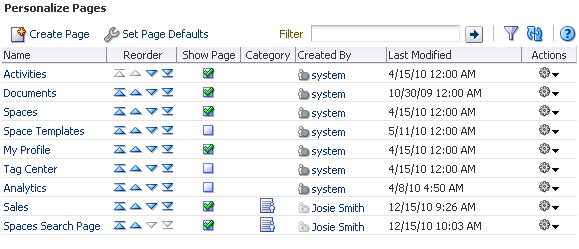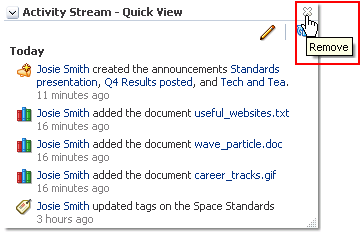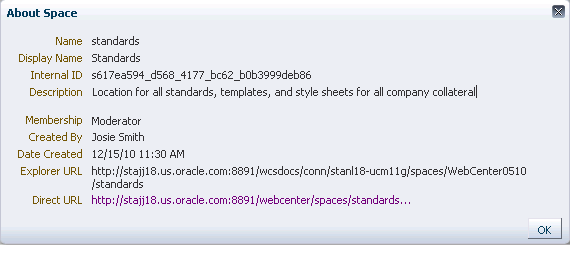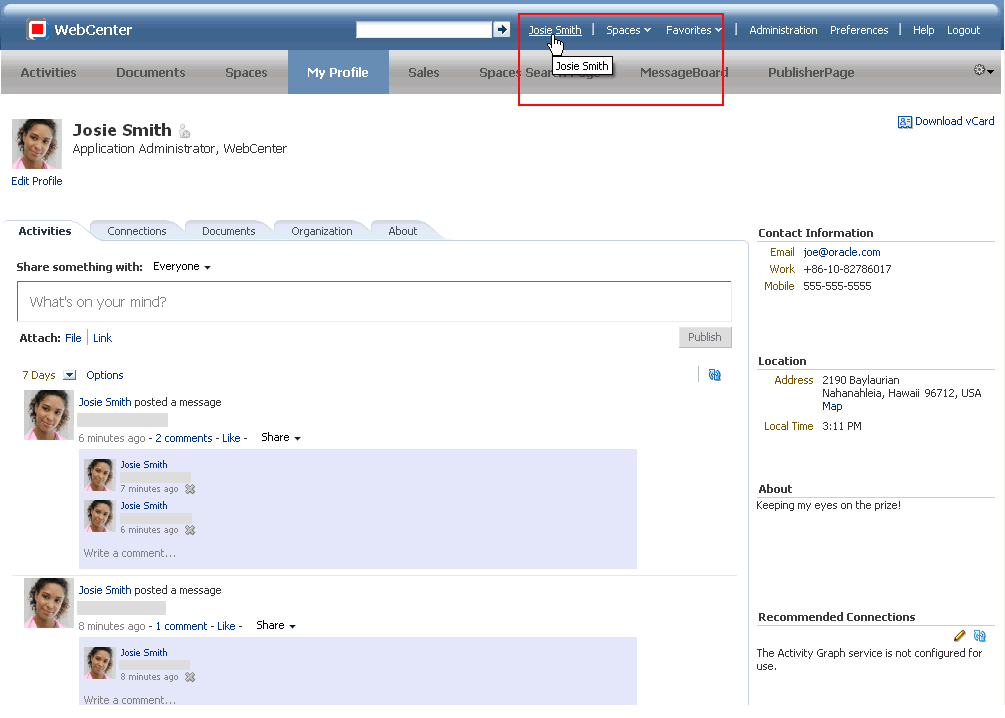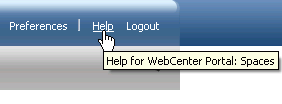29 Exploring the Home Space
This chapter provides basic information to get you started in the Spaces application Home space. It includes the following sections:
-
Section 29.2, "Registering Yourself with WebCenter Portal: Spaces"
-
Section 29.5, "Exposing a Space Page in Your View of the Home Space"
-
Section 29.11, "Accessing WebCenter Portal: Spaces Online Help"
This chapter is intended for users minimally assigned the role Authenticated-User, that is, any user who is logged in, who wants to understand basic information about Spaces application self-registration, Home spaces, page access, and online help. To create and manage pages in a Home space, you must be granted, minimally, Pages: Create, Edit, and Delete Pages.
29.1 What You Can Do In the Home Space
Provided your portal administrator has granted you the permissions to do so, you can create pages in the Home space, edit those pages, rename them, rearrange them, and add content to them. Such pages are for your view only, unless you specifically share them with other users.
To have page create and manage privileges in the Home space makes almost all of the information in this guide useful to you, no matter your position in your company's hierarchy. For example, you can use the information in Chapter 38, "Creating and Managing Personal Pages," to create and manage your personal pages and to share such pages with the users you specify.
Note:
Application administrators may choose to prohibit the creation of personal pages in the Home space, allowing only the display of business role pages and system pages, over which you have less control.
You can use the information in Chapter 17, "Building Pages," to add content to your pages and to configure that content.
You can use the information in Part X, "Working with Content", Part XIII, "Searching WebCenter and Other Sources", Part XV, "Services: Announcements through Links", and Part XVI, "Services: Lists through Worklist" to take advantage of the many services and their associated task flows provided out of the box.
Tip:
Some services are active only in spaces other than the Home space. These include such services as Discussions, Events, Announcements, and Lists.
This chapter provides a basic orientation to the types of actions you can take in the Home space. Note that the actions discussed here and in the chapters cited earlier apply primarily to the personal pages you create in the Home space. There are other types of pages, too, over which you have fewer default permissions.
For example, the Home space may contain business role pages, that are provided to you by your application administrator. Business role pages are pushed to your view of the Home space based on your assigned application role. For example, if you are part of the Sales team, there may be a business role page in your view of the Home space that you and all the members of the Sales team can access.
Additionally, there are system pages. System pages are typically utility pages that, in the Home space, either expose your personal view onto a given service, such as the Documents page or the Activity Stream page, or provide an application-wide function, such as the Self-Registration page.
Keep this in mind: though you own and operate your personal pages in the Home space, your application administrator sees all, and can access anyone's personal pages, no matter the security settings you put in place.
29.2 Registering Yourself with WebCenter Portal: Spaces
Your Spaces application administrator may provide the opportunity to self-register to the Spaces application. Self-registration enables you to create your own login credentials and enter the Spaces application from there forward as an authenticated user. The privileges of authentication are many: your own view of the Home space, access to other features based on your assigned user role, a broader range of available interactive features, to name a few.
Note:
Whether self-registration is available depends on how your Spaces application administrator configures the application.
To register yourself as a Spaces application user:
-
Open the Spaces application.
For example:
http://host:port/webcenter
Where
<host>:<port>refers to the host name and port number of the system where WebCenter Portal: Spaces is installed. By default, the Spaces application is installed on port 8888. -
Click the Register button on the application Welcome page (Figure 29-1).
Note:
Your Spaces application administrator can customize the look and feel of the Login page, but the information depicted in Figure 29-1 is essentially the same whatever the customization.
See Also:
Advanced users can extend the Spaces application by customizing, for example, where the Login fields and buttons appear. For more information, see Section 7.3.2, "Customizing System Pages."
Figure 29-1 The Register Button on the Welcome Page
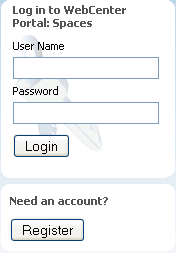
Description of "Figure 29-1 The Register Button on the Welcome Page"
-
On the resulting Self-Registration page (Figure 29-2), enter your user information:
Note that fields marked with an asterisk require a value.
Tip:
Your application administrator can customize the Self-Registration page, so it may not appear as depicted in Figure 29-2.
Figure 29-2 WebCenter Portal: Spaces Self-Registration Page
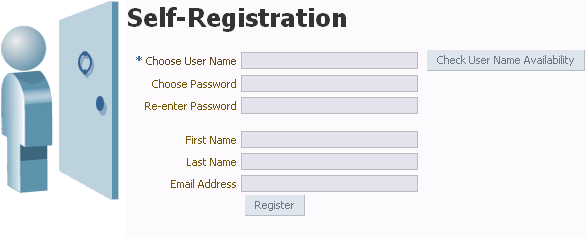
Description of "Figure 29-2 WebCenter Portal: Spaces Self-Registration Page"
Before you begin, you should know that the user name and password policy is set by the underlying identity store. Your application administrator may customize the Self-Registration page to include information that explains your organization's user name and password policy.
-
Enter your preferred user name in the Choose User Name field.
-
Click the Check User Name Available button to ensure the uniqueness of your chosen user name.
If the name you entered is in use, provide another user name and test that. Continue this cycle until the check assures you that your entry is unique.
-
Provide a password in the Choose Password field.
-
Reenter the password in the Re-enter Password field.
-
Enter your first name in the First Name field.
-
Enter your last name (that is, your surname) in the Last Name field.
-
Enter your company email address in the Email Address field.
-
-
Click the Register button.
If the data you entered is accepted, a log-in dialog opens, enabling you to log in to the Spaces application.
Note:
By default, if a user name with the same mail ID exists, when you click Register, a dialog opens informing you that the mail ID exists. The dialog includes a button for sending a message to the mail ID associated with the existing user name.
Because you are not yet authenticated, your message is sent to a public mail box, provided your application administrator has configured public mail credentials.
Note that this default behavior may be overridden by customizations provided by your portal developers.
29.3 Hiding, Opening, and Rearranging Pages
Showing and hiding pages is a user customization. That is, such changes affect only your view of the application. Pages are not simultaneously shown or hidden in other users' application views.
The type of navigation that is in place in a given space affects which steps you take to hide, show, open, and close that space and its pages. Administrators and space moderators can set up navigation as they choose. The procedures in this section are offered as examples of how to hide, show, open, and close spaces and pages and how to rearrange page order. Your methods may differ based on your portal's navigation.
This section includes the following subsections:
29.3.1 Opening Spaces
Two types of spaces may be available to you in your portal: a space, which is exposed to a group of users who are working toward a common goal, and the Home space, which is for everyone (the application administrator may also provide you with options for creating and managing your own personal pages in the Home space). This section provides examples of how to open both types of space. It includes the following subsections:
29.3.1.1 Accessing the Home Space
This section provides examples of how to access the Home space. Your portal navigation may differ, and may therefore not respond to these approaches. These examples should, nonetheless, provide some ideas for how to go about this action in your own portal.
Examples of ways to access the Home space:
-
Use the following URL:
http://host:port/webcenter/spaces/home
Where
<host>:<port>refers to the host name and port number of the system where WebCenter Portal: Spaces is installed. By default, the Spaces application is installed on port 8888.See Also:
For additional URLs to use in navigating to pages, see Appendix A, "Spaces User Interface URLs."
-
Click your user name where it appears as a link in the application, for example, Figure 29-3.
Figure 29-3 Example of a User Name as a Link

Description of "Figure 29-3 Example of a User Name as a Link"
This takes you to the My Profile page in the Home space.
-
Open the Spaces Switcher menu and click Home Space (Figure 29-4).
Figure 29-4 Home Space Option on the Spaces Switcher Menu
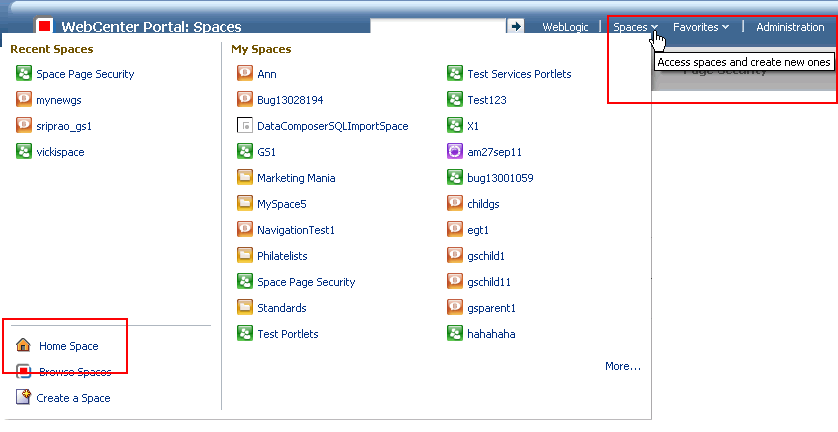
Description of "Figure 29-4 Home Space Option on the Spaces Switcher Menu"
29.3.1.2 Accessing a Space
This section provides examples of how you can access spaces other than the Home space. Your portal navigation may differ, and may therefore not respond to all of these approaches. These examples should, nonetheless, provide some ideas for how to go about accessing a space in your own portal.
Examples of ways to access spaces other than the Home space:
-
Use the following URL:
http://host:port/webcenter/spaces/spaceName
In lieu of
spaceName, enter the name of the space.For
<host>:<port>, enter the host name and port number of the system where WebCenter Portal: Spaces is installed. By default, the Spaces application is installed on port 8888.See Also:
For additional URLs to use in navigating to pages, see Appendix A, "Spaces User Interface URLs."
-
In any space, open the Spaces Switcher menu and click the name of the destination space, or click Browse Spaces to access the Spaces page (Figure 29-5).
Figure 29-5 Browse Spaces Option on Spaces Switcher Menu
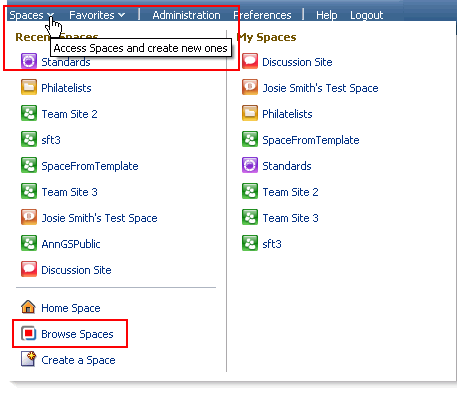
Description of "Figure 29-5 Browse Spaces Option on Spaces Switcher Menu"
You can use the Search feature on this page to locate a specific space.
Note:
The way that you open the Spaces Switcher menu depends on the page template in use. For example, you may open it by clicking a menu icon to the right of the space name.
29.3.2 Opening Pages
You have a few options for opening pages. How you proceed depends on the controls your application administrator or space moderator has made available to you and the navigation model in use. In all configurations, however, you can open pages using a pretty URL or through the Personalize Pages page (Figure 29-6).
To open pages:
-
To open pages in the Home space, use the following URL:
http://host:port/webcenter/spaces/page/escapedPageDisplayName
For
<host>:<port>, enter the host name and port number of the system where the Spaces application is installed. By default, the application is installed on port 8888.Tip:
The variable
escapedPageDisplayNameindicates the use of an escaped version of the page display name. For example, when you create a page with the name My Page, the URL to this page ends withMy+Page. -
To open pages in a space, use the following URL:
http://host:port/webcenter/spaces/spaceName/page/escapedPageDisplayName
See Also:
For additional URLs to use in navigating to pages, see Appendix A, "Spaces User Interface URLs."
-
Open the Personalize Pages page, and click the name of the page you want to open (Figure 29-7).
Figure 29-7 Opening a Page through the Personalize Pages Page
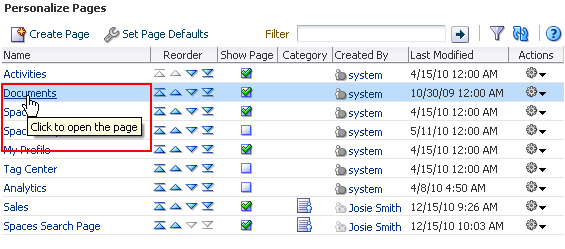
Description of "Figure 29-7 Opening a Page through the Personalize Pages Page"
29.3.3 Hiding Pages
As you add pages to spaces, it may become useful to hide some less-frequently-used pages. Once a page is hidden, it is easy to restore it to view (see Section 29.3.4, "Showing Hidden Pages").
To hide a page:
-
Go to the space with pages you want to hide, and open the Personalize Pages page.
See Also:
For more information, see Section 29.3.2, "Opening Pages."
-
Clear the Show Page checkbox for each page you want to hide.
Note:
If you clear the Show Page checkbox for the current page, the Personalize Pages page closes and the current page is hidden.
Within a particular scope, such as a space or the Home space, one page must always be shown; therefore, you cannot use this method to hide all pages within a particular scope.
29.3.4 Showing Hidden Pages
-
Go to the space with pages you want to show, and open the Personalize Pages page.
See Also:
For more information, see Section 29.3.2, "Opening Pages."
-
Select the Show Page checkbox for each page you want to show.
29.3.5 Rearranging Page Order
In a space, you can use the Personalize Pages page to change the order in which pages are listed or arranged. When you change page order on the Personalize Pages page, you are doing so in your own view only. That is, it is a user customization that affects only your view of the page.
Note:
There are two ways of defining the order and the visibility of pages in a space: from the Administration pages (described in Section 7.1.7, "Setting a Default Display Order for Business Role Pages") and from the Personalize Pages page (described here). The difference between the two is that the Administration change is an application customization and the Personalize Pages change is a user customization. Keep in mind that user customizations override application customizations in a given user's view.
See Also:
F or more information about user customization, see Section 29.4.1, "What You Should Know About User Customizations on a Page."
For information about the difference between user- and application-level customizations, see Section 17.5.2.1, "What You Should Know About Customizing Page Components."
To rearrange page order:
-
Go to the space with pages to rearrange, and open the Personalize Pages page.
See Also:
For more information, see Section 29.3.2, "Opening Pages."
-
Use the icons in the Reorder column to rearrange page order (Figure 29-8).
Figure 29-8 Reorder Icons on the Personalize Pages Page

Description of "Figure 29-8 Reorder Icons on the Personalize Pages Page"
Pages are now arranged in the order you specified.
29.4 Adjusting Your Page View
The Spaces application provides many opportunities for changing your view of a given page. This includes rearranging your view of page content, hiding components, changing your page layout, and the like. All of these options are user customizations, that is, they affect only your view of the application. All other users' views remain unchanged.
See Also:
For information about the difference between user- and application-level customizations, see Section 17.5.2.1, "What You Should Know About Customizing Page Components."
This section steps you through the process of adjusting your own page view through user customization. It includes the following subsections:
-
Section 29.4.1, "What You Should Know About User Customizations on a Page"
-
Section 29.4.2, "Performing User Customizations on Your Page View"
-
Section 29.4.3, "Removing All of Your User Customizations from a Page"
29.4.1 What You Should Know About User Customizations on a Page
You can customize the way pages appear in many ways without opening the page editor (Composer). For example, you can reposition, remove, resize, and collapse components, all within just your view of a page.
User customizations are yours and yours alone. That is, the changes you make through the procedures described in the following sections affect only your view of the Spaces application. No other users are affected by your changes.
For example, when you reposition page components in page view mode, that change applies only to your view of the page. Other users may reorganize their own views of pages, and their changes do not affect your view—only their own.
Note:
When you revise a component in page view mode while another user deletes the same component in page edit mode, a WebCenter error page opens. Simply navigate back to the original page. The deleted component does not appear, and you can continue working on other components.
See Also:
Advanced users with sufficient permission can change everyone's view of a page. For more information, see Section 17.3, "Editing Pages."
29.4.2 Performing User Customizations on Your Page View
Whether you can customize a page depends on permissions granted to you or your application role and on how user customizations are configured. You can tell if you have such permission by the presence or absence of the controls discussed in this section. If you do not see these controls, contact your application administrator to ask for a higher-level of access or for a configuration change.
Tip:
An Administrator link for contacting your application administrator may be available to you in the Spaces UI, depending on the design of your portal.
This section describes how to perform the user customizations rearrange, resize, minimize, and maximize. It includes the following subsections:
29.4.2.1 Rearranging Page Content
Use drag-and-drop to rearrange the position of a component on a page. Components moved by drag-and-drop can be moved into any open position on a page.
Dragging and dropping is arguably the easiest and least restricted way to rearrange components on a page. Simply drag the component over the spot you want to place it and drop it there. A shadow indicates a receptive drop location (Figure 29-9).
Figure 29-9 Shadow Indicating a Receptive Drop Location

Description of "Figure 29-9 Shadow Indicating a Receptive Drop Location"
To rearrange components by dragging and dropping:
-
Go to the page of interest.
See Also:
For more information, see Section 29.3.2, "Opening Pages."
-
Click and hold the header of the component you want rearrange, drag it to its target position, and drop it onto the page.
A shadow indicates where the component is placed when you drop it (Figure 29-10).
Figure 29-10 Dragging an Issues List Above an Events Task Flow
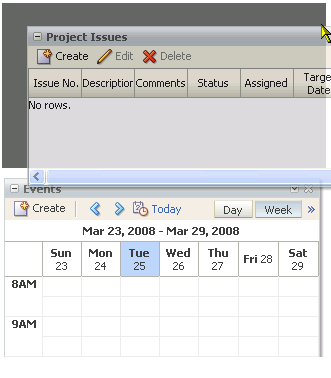
Description of "Figure 29-10 Dragging an Issues List Above an Events Task Flow"
29.4.2.2 Removing Components from Your View of a Page
If you find that a component, such as a task flow or portlet, is not useful to you and the component displays a Remove icon (Figure 29-11), you can remove it from your view of the page.
Keep in mind that you can restore a removed component only by editing the page and adding a new component instance (for more information, see Section 17.5, "Adding Resource Catalog Components to Pages").
To remove a component from your view of a page:
-
Go to the page of interest.
See Also:
For more information, see Section 29.3.2, "Opening Pages."
-
Click the Remove icon on the component header (see Figure 29-11).
The component is removed from your view of the page.
29.4.2.3 Resizing Components
The border and header surrounding a component, such as a task flow or a portlet, is also known as chrome. Chrome can clarify the boundaries of the component and provide an access point for component actions, such as those on the Actions menu and those embedded in the chrome itself. In the latter case, the chrome may include a Resize handle that you can use to increase or decrease the height of the component (Figure 29-12).
Figure 29-12 Resize Handle on a Task Flow

Description of "Figure 29-12 Resize Handle on a Task Flow"
Note:
The position of the resize handle differs for bidirectionally displayed components. Those components displayed in a right-to-left orientation display the resize handle on the left side.
To use this feature, click and hold the Resize handle and drag it up to decrease the height of the component or down to increase the height of the component.
29.4.2.4 Collapsing and Expanding Components
With one click, you can collapse some components, such as task flows or portlets, so that they roll up like a window shade, leaving only their headers on view (Figure 29-13).
With another click, you can expand a collapsed component (Figure 29-14).
Figure 29-14 Collapse/Expand Icon on a Task Flow
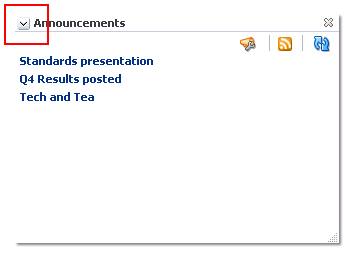
Description of "Figure 29-14 Collapse/Expand Icon on a Task Flow"
Collapsing is useful for removing the visual noise of an unused component from your application view. Collapse is available when a component shows a header.
To collapse and expand components:
-
Go to the page of interest.
See Also:
For more information, see Section 29.3.2, "Opening Pages."
-
Click the Collapse icon on the component header to roll the component up like a window shade (Figure 29-15).
Figure 29-15 Collapse/Expand Icon on a Task Flow

Description of "Figure 29-15 Collapse/Expand Icon on a Task Flow"
-
Click the Expand icon on the component header to restore the full component to view (Figure 29-16).
29.4.3 Removing All of Your User Customizations from a Page
A control is available for removing all of your user customizations from a selected page. Using this control removes such personal changes as rearrangement, resizing, or collapsing of task flows. It does this in only your view of the page.
To remove all of your user customizations from your view of a page:
-
In the space of interest, open the Personalize Pages page.
For information on how to navigate to this page, see Section 29.3.2, "Opening Pages."
-
From the Actions menu next to the target page, select Reset Layout.
-
In the resulting dialog, click OK.
29.5 Exposing a Space Page in Your View of the Home Space
You can expose some space pages within your view of the Home space. For example, if you would like to keep close track of a space page named Sales Results, you can specify that the Sales Results page should be available in your view of the Home space.
Note:
System pages that are exposed in a space, such as Events, Lists, and Announcements, do not provide the option of being exposed in the Home space, nor do wiki and blog pages. For information about System pages, see Section 7.3, "Working with System Pages."
The page is available for viewing and revising from within your view of the Home space according to your permissions on the page. The space name is prepended to the page name, so, in your view of the Home space, the Sales Results page in the space Finance becomes Finance - Sales Results.
If you delete such a page from your view of the Home space, it remains a part of its original space. In other words, deleting it from the Home space simply removes it from your view; it does not actually delete the page. If the page is deleted from its parent space, it is unavailable in your view of the Home space. To clear it from your view, you must refresh the page list in the Home space's Personalize Pages page.
Tip:
Personalize Pages is an option on the Page and Spaces Actions menu. How you access this menu depends on your portal design.
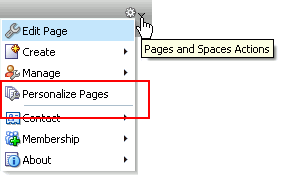
Description of the illustration wcsug_learn_pandsactions.gif
To expose a space page in your view of the Home space:
-
Go to the space that contains the page of interest.
See Also:
For more information, see Section 29.3.1, "Opening Spaces."
-
Access the space's Personalize Pages page.
-
Open the Actions menu next to the page of interest, and select Add to Home Space (Figure 29-17).
Figure 29-17 Add to Home Space Option on the Actions Menu

Description of "Figure 29-17 Add to Home Space Option on the Actions Menu"
29.6 Renaming a Page
When you rename a page, keep in mind that any pretty URLs that use the old name will be broken. Also note that system pages, such as the Announcements, Lists, and Events pages, do not provide the option of being renamed.
See Also:
For information about pretty URLs, see Appendix A, "Spaces User Interface URLs."
-
Go to the space that contains the page of interest.
See Also:
For more information, see Section 29.3.1, "Opening Spaces."
-
Access the space's Personalize Pages page.
-
Open the page's Actions menu, and select Rename Page (Figure 29-18).
Figure 29-18 Rename Page Option on Actions Menu
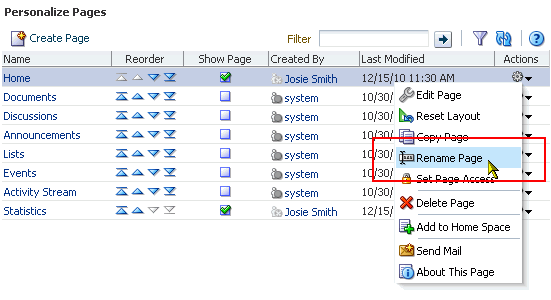
Description of "Figure 29-18 Rename Page Option on Actions Menu"
-
Revise the page name, and click Save.
29.7 Sending a Link to a Page
-
Go to the space that contains the page of interest.
See Also:
For more information, see Section 29.3.1, "Opening Spaces."
-
Open the space's Personalize Pages page.
-
Open the page's Actions menu, and select Send Mail (Figure 29-19).
Figure 29-19 Send Mail Option on Actions Menu
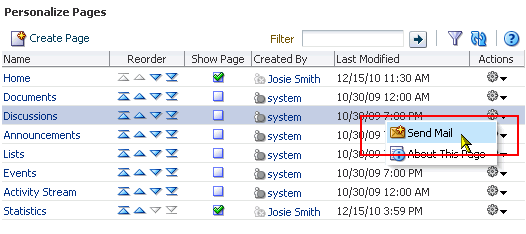
Description of "Figure 29-19 Send Mail Option on Actions Menu"
A compose mail window containing the URL to the current page opens. Compose and send the message as you would any other mail message.
The compose message window opens either in your native mail application or in the Spaces application mail compose window, depending on how your application administrator has configured this feature. If the administrator has made such controls available to users, you may define for yourself which mail client opens. For more information, see Section 65.3, "Selecting Your Preferred Mail Connection."
29.8 Previewing and Printing an Application Page
Use the Print Preview option to preview and print pages that largely contain text. Print options are useful for pages where content is mainly text, such as the Announcements page, wiki and blog pages, and other custom pages comprised primarily of text.
Note that the Print Preview link may not be present if your application designer has not made it available.
See Also:
For information about the Print Preview link, see Section 13.2.27, "Print Preview."
To preview and print an application page:
-
Go to the space that contains the page of interest.
See Also:
For more information, see Section 29.3.1, "Opening Spaces."
-
Click the page's Print Preview link.
A printable version of the page opens in a new browser tab or window. Print the page by pressing Ctrl-P, or simply preview the page.
29.9 Viewing Space and Page Information
Every space and every page has associated information, called metadata. space and page metadata include such information as display name, internal identification (GUID), description, membership role (spaces only, that is, not the Home space), user name of the creator, date created, and direct URL.
This section provides information about how to access space and page information. It includes the following subsections:
29.9.1 Accessing Space Information
To access information about a space:
-
Go to the Spaces page.
See Also:
For information about accessing the Spaces page, see Section 29.3.1.2, "Accessing a Space."
-
Right-click the space of interest, and select About and then About this Space (Figure 29-20) to open the About Space dialog (Figure 29-21).
Figure 29-20 About this Space Option on Space Context Menu
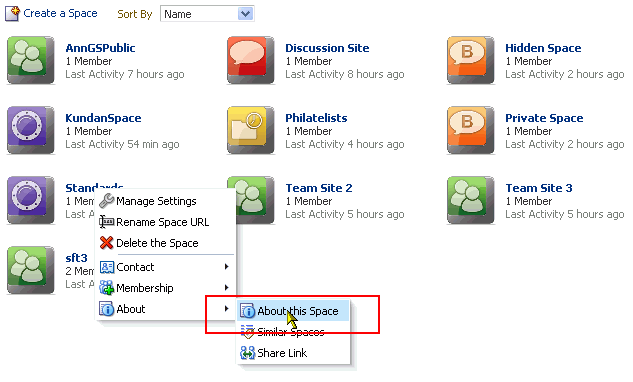
Description of "Figure 29-20 About this Space Option on Space Context Menu"
-
Click OK to close the dialog.
29.9.2 Accessing Page Information
To access information about a page from the Personalize Pages page:
-
Go to the Personalize Pages page in the Home space or the space that includes the page of interest.
Tip:
Personalize Pages is an option on the Page and Spaces Actions menu. How you access this menu depends on your portal design.

Description of the illustration wcsug_learn_pandsactions.gif -
Open the page's Actions menu (Figure 29-22), and select About This Page to open the Page Information dialog (Figure 29-23).
Figure 29-22 About this Page Option on Personalize Pages Page

Description of "Figure 29-22 About this Page Option on Personalize Pages Page"
-
Click OK to close the dialog.
29.10 Viewing Your Personal Profile Gallery
When you log in to the Spaces application, you may notice your user name at some position in the application user interface. Click this to open your personal profile gallery (Figure 29-24).
Your personal profile gallery presents a series of tabs, each devoted to information of interest to you:
-
Activities—Provides a Publisher, which you can use to make statements about your personal status and provide links to external or internal objects; and an Activity Stream, which streams information about the activities of you and your connections. For more information, see Chapter 32, "Tracking Your Connections' Activities," and Chapter 34, "Liking, Commenting On, and Sharing Objects."
-
Connections—Provides a view of all of your connections and features for managing your connections. Chapter 31, "Creating Your Social Network."
-
Documents—Provides a view of your personal document library. For more information, see Part X, "Working with Content".
-
Organization—An organization chart that depicts you and the organization members directly associated with you. For more information, see Chapter 30, "Managing Your Profile."
-
About—Your personal profile details. For more information, see Chapter 30, "Managing Your Profile."
29.11 Accessing WebCenter Portal: Spaces Online Help
Wherever you see a Help link or a Help button, click it to access help.
The Help link (Figure 29-25) opens the application's main help page. From there, you can navigate to topics of interest.
Help buttons, located throughout the application, open help topics that describe what is currently shown.
